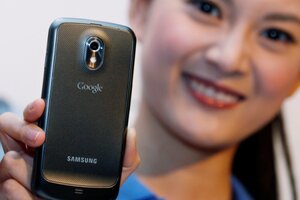Galaxy Nexus, Android 4 'Ice Cream Sandwich' revealed
Google unveiled Android 4.0 'Ice Cream Sandwich' as Samsung showed off the Galaxy Nexus, the first Android 4 handset. With the just-announced Droid RAZR, Android enthusiasts have lots to get excited about.

A model displays the new Galaxy Nexus smartphone during a news conference in Hong Kong Oct. 19, 2011. South Korea's Samsung Electronics Co. Ltd. on Wednesday unveiled its Galaxy Nexus smartphone, the first to use the latest version of Google's Android 4.0 operating system, known as 'Ice Cream Sandwich.'
Kin Cheung/AP
American tech enthusiasts had to stay up late on Tuesday night to catch Google and Samsung’s announcement at the AsiaD conference in Hong Kong, but those who did were well rewarded: Google revealed “Ice Cream Sandwich,” the highly anticipated fourth iteration of the Android operating system, and Samsung raised the curtain on the first smartphone to run Android 4.0: the Galaxy Nexus.
Let’s talk about the hardware first. The Galaxy Nexus sports a gargantuan 4.65-inch HD Super AMOLED display and a slightly curved body and face (unlike a certain other phone we could name, that recently debuted with a flat face in spite of rumors to the contrary). It packs a 1.3 megapixel front camera, 5-megapixel rear camera and flash, and according to Samsung's announcement, no shutter lag.
Under the hood, there’s a 1.2GHz dual-core processor, 16 or 32GB of built-in storage space, and a near-field communication (NFC) module – more on that last feature in a second. We know from published leaks that the Galaxy Nexus will be available on Verizon in the United States; Samsung announced that the handset will be carried by NTT Docomo in Japan as well as Vodafone, O2, and a handful of others in Europe.
Let’s move on now and unwrap Google’s delicious Ice Cream Sandwich. The new Android will undoubtedly become available on other handsets, but for now, the Galaxy Nexus is the only game in town, and the launch event suggests the handset and operating system are optimized for each other. Those who have used Ice Cream Sandwich on the Galaxy Nexus already, including Darren Murph at Engadget, report that it’s a snappy, buttery smooth experience.
What’s been changed in Android this time around? A number of enhancements in Ice Cream Sandwich bring it closer in line with Apple's iOS, including drag-and-drop folders, improved copy and paste, and a more full-featured camera app with a few editing features. There are also some human touches, such as better integration of voice commands and a nifty service that lets your phone recognize your individual face and unlock accordingly.
Those customers on a tiered data plan (so, pretty much all smartphone users in the US) will be pleased with Ice Cream Sandwich’s data usage setting, which lets your phone alert you when you’ve consumed a certain amount of data each month, and cut it off entirely once you hit a certain threshold. It’s a clever way to avoid accidental overage charges. And remember the Galaxy Nexus’s NFC chip that we mentioned earlier? In addition to wireless payments, you’ll be able to use that for Android Beam, a feature that lets you bump two NFC-enabled devices together to exchange contact information, links, maps, and other data.
Between the Galaxy Nexus and the just-announced Motorola Droid RAZR, Android fans have plenty of flagship devices to choose from. What do you think about these new phones? How about Ice Cream Sandwich – are you excited to sink your teeth in, or holding back to see how things go? Sound off in the comments.
For more tech news, sign up for the weekly BizTech newsletter, which ships every Wednesday.
